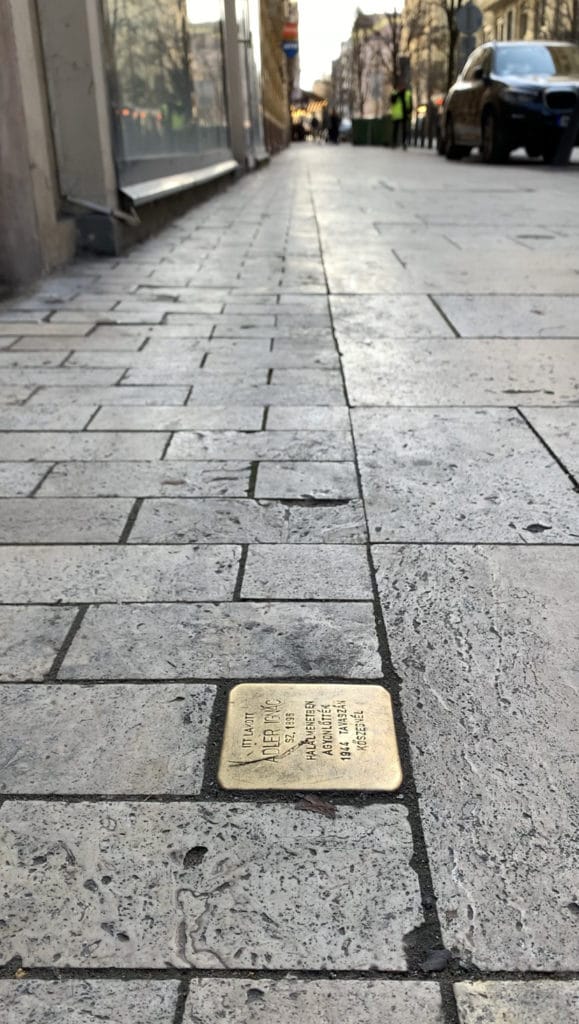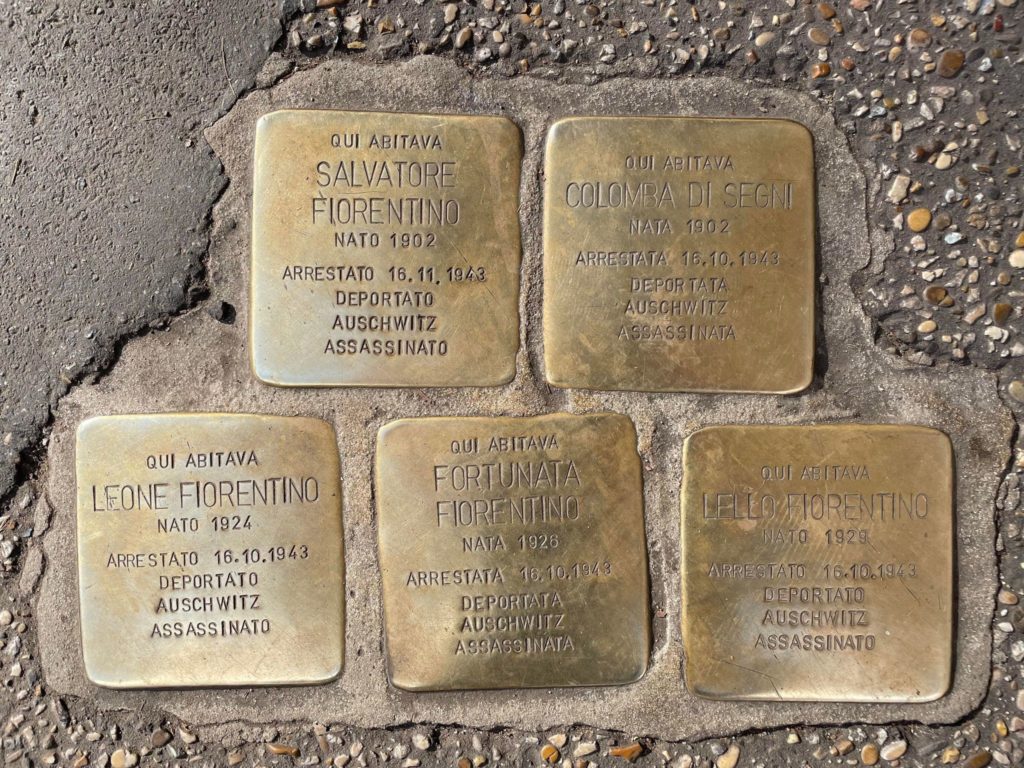Generally, we keep our eyes up while walking, but sometimes, what we need to see is below our feet— that’s what I learned while visiting Budapest in the winter of 2022, when a small, shiny brass plaque on the ground caught my eye.
Perfectly embedded between the street’s cobblestones – easy to miss – the plaque was at the foot of a modest apartment building a short walk from the Hungarian Parliament.

In Hungarian it read:
Here lived:
Adler Ignac
Born 1896
Murdered in the spring of 1944
My friend who was living in Budapest at the time clued me in:
The unassuming plaque is one of approximately 90,000 brass memorial plaques meant to commemorate victims of the Holocaust. Known as Stolpersteine, German for “stumbling stones,” the plaques are laid at the entrance of the homes where individual victims of the Holocaust once lived before being viciously rounded up by the Nazis.
The inscription on each stone begins “Here lived,” followed by the victim’s name and any known information about them, including date of birth and their fate, which in the vast majority of cases, is deportation and murder.
Together, the Stolpersteine constitute the largest decentralized monument in the world, honoring the memory of victims who, in most cases, do not have the dignity of graves.
The idea was first conceived by German artist Gunter Demnig in 1992.
The Nazi’s wanted to “exterminate people, turn them into numbers and erase their memory,” Demnig said. He wants to reverse this process and return individual names to places where people once lived.
Citing the Talmud, Demnig said: “A person is only forgotten when his or her name is forgotten.”
The Stolpersteine are meant to cause a mental “stumbling” that forces pedestrians to reckon with the past.

To date, Demnig has laid over 90,000 stones in more than 1600 cities and towns across Europe, Russia and Ukraine. He personally oversees the wording and installation of each one – a task which apparently kept him on the road for 300 days a year prior to the COVID-19 pandemic.
“The project is not only about the victims and their fates,” he said, “but about the installation of the stones which commemorate them.”
Demnig insists that each stolpersteine be made by hand. He no longer has time to make them himself, so sculptor Michael Friedrichs-Friedlaender crafts each stone in his Berlin studio.
13 of Munich's 145 Stolpersteine. 90,000 Stolpersteine in 1,600 cities in 26 countries. The world's project of Holocaust commemoration. Created and led by Gunter Demnig, one of the greats of our generation. pic.twitter.com/QhcDwVOAHE
— Terry Swartzberg (@Stosteimuenchen) June 13, 2021
“To show respect for the victims, it must be done by hand,” Friedrichs-Friedlaender told The Guardian. “The Holocaust was so systematic. What they invented as means of mass slaughter, it was more or less automatised. We don’t want anything like that.”
The craftsman engraves each stone by hand, letter by letter, with a hammer and hand-held metal stamps.
Despite its international scope, Stolpersteine remains a grassroots initiative. Often, local groups – such as residents of a particular street or students working on a project – come together to research the biographies of local victims, and raise the 120 euros it costs to install each stone.
Most recently, students in Brussels organized teams of volunteers to clean all 458 Stolpersteine in the city in advance of Yom HaShoah (Holocaust Remembrance Day) as a part of a campaign called “Make Their Memory Shine.”
Taking the day off to #MakeTheirMemoryShine, cleaning the #stolpersteine in Brussels. pic.twitter.com/PDg2srdZky
— Sarah Wheaton (@swheaton) April 27, 2022
Once you keep an eye out, you’ll notice these small hand-crafted Stolpersteine everywhere, my friend living in Budapest pointed out.
“I just saw some in Italy,” he told me. “I always stop and take the time to read them. To think about what that person or that family’s life might have been like in the place they once called home.”
“Those victims don’t even have the dignity of graves. They only have us. Without us, who will remember not only their tragic fate, but also the vibrancy of their lives?”
Adler Ignac was shot dead by Nazis in the spring of 1944 during a death march in the town of Köszeg, Hungary. His memory is preserved by a Stolpersteine on Oktober 6 Street in Budapest.


